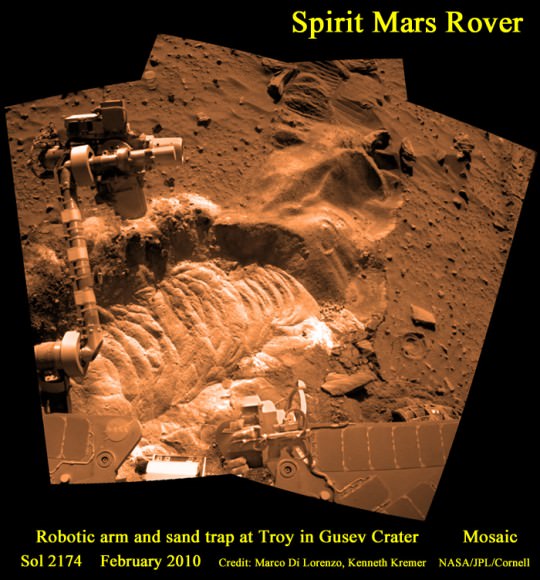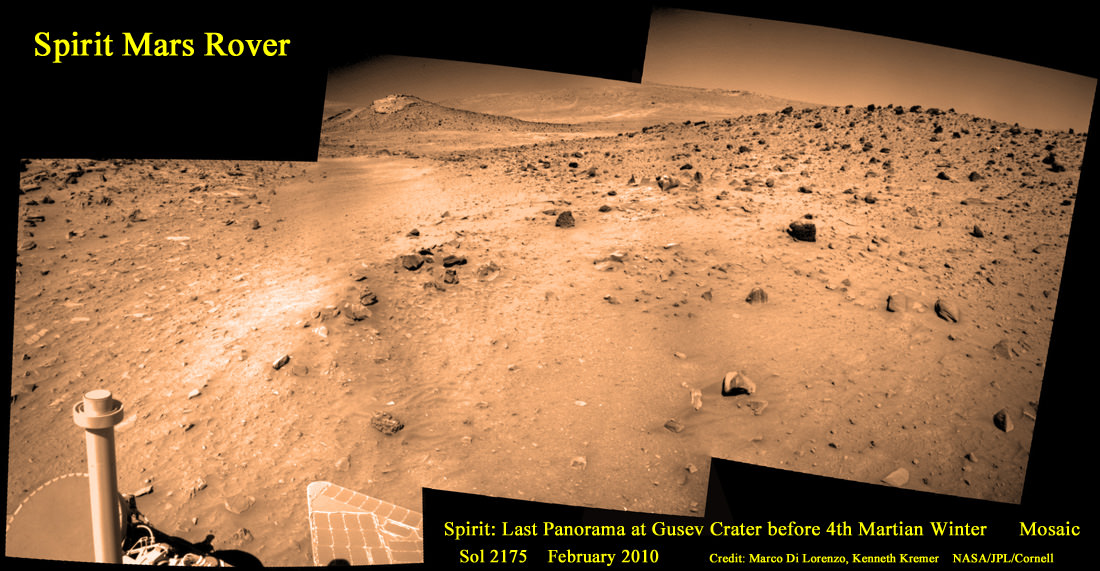[/caption]
“Spirit is hanging in there … remarkably good, all things considered”, Steve Squyres told me in a rover update this week. Squyres is the Scientific Principal Investigator for the twin Mars rovers, Spirit and Opportunity.
I asked Squyres whether the rover team would give extrication efforts a top priority if Spirit survives the harsh freezing temperatures of the looming winter season ?
Squyres replied that, “If Spirit survives the winter then we’ll start turning wheels again when there’s enough power to do so, and we’ll see what happens. Even if we only get tens of centimeters of motion, there’s great scientific value in doing so”.
That’s because the Martian terrain where Spirit has been mired in a sand trap since April 2009 has proven to a scientific bonanza and yielded some of the best evidence for past episodes of flowing liquid water. Spirits wheels are buried in sulfate-rich deposits which were formed by water-related processes when volcanism was active around the location dubbed ‘Home Plate’.
See our new mosaic above of the final panorama taken by Spirit on Sol 2175 before the onset of winter. See our mosac below of the Troy sand trap and the final positional placement of the robotic arm (IDD) on Sol 2174.
With Martian winter in the southern hemisphere fast approaching and power declining as the sun rises lower in the martain skies, Spirit’s rover electronics module (REM) has now reached a new record low temperature of minus 41.5 degrees Celsius (minus 42.7 degrees Fahrenheit).
As of today, Spirit has survived for 2217 Sols, or martian days, compared to the 90 Sol “Warranty” stipulated at launch. If she survives for approximately three more weeks, she’ll smash the record for longevity of any human made robot on Mars. Viking 1 is the longest lived surface mission and sent her last signal on Sol 2245 on November 11, 1982 for a total operating time of 6 Year and 116 days.
The rover team has projected that the temperature experienced by the critical electronics will likely drop down a bit further to perhaps minus 45 degrees Celsius as Spirit endeavors to endure an unprecedented 4th extreme winter at Gusev Crater on Mars while stuck in a sand trap at the place called Troy. “The temperature could go lower… but not by a great deal,” Squyres added.

Picture Caption: Spirit is parked for 4th martian winter in the embedded area called “Troy” on the west side of Home Plate in Gusev Crater. On Sol 2174 (Feb. 13, 2010), the robotic arm (IDD) was positioned to the most favorable orientation for winter. Documentary imaging was collected of the terrain and rover. Credit: Marco Di Lorenzo, Kenneth Kremer NASA/JPL/Cornell
Energy output from the solar arrays likewise continues to drop at the same time as the energy required to run the survival heaters for the electronics continues to increase. This means that the power deficit gap between what is available and what is required will continue to widen and eventually could trigger a low power fault resulting in Spirit entering hibernation mode.
No one knows precisely when the low power fault will occur and the team has been working diligently to find new ways of shaving off power usage to stave off the day when Spirit enters hibernation because no one knows if her critical components will last intact so that she will reawaken at a later date as the climate improves.
Squyres commented regarding the potential trigger point for a low power fault by saying, “Our initial guess was 155 watt hours, and the latest number we’ve seen is 133 watt-hours (March 22). So I’m not even going to try to guess”.
Mars rover driver Scott Maxwell reports via recent Twitters that, “Spirit is still alive and talking to us. Feisty girl. Brilliant uplink team found way to shave Spirit’s energy needs; can get by with 120ish [watt-hours] now. Might stave off hibernation another couple weeks!
Spirit will continue to execute a single seven-sol plan each week, as long as power permits. The seven-sol plan contains a single X-band uplink and a single Ultra-High Frequency (UHF) downlink, according to an update by the Jet Propulsion Laboratory which manages the rover project for NASA. The activity on each sol consists simply of a brief wakeup, an atmospheric opacity (tau) measurement, and then a shutdown for the rest of the day and night.
Back on January 26, 2010, NASA declared Spirit would henceforth be a “stationary lander” after exhaustive extrication efforts failed to ‘Free Spirit’. But in her last re-positioning movements to improve her tilt to the sun and thereby increase her solar energy output, Spirit actually moved about 13 inches.
At that time Squyres said that Spirit could continue to produce significant science as a “stationary lander”. He was most excited about the possibility to study tiny wobbles in the rotation of Mars to gain insight about the planet’s core. This requires months of radio-tracking the motion of a point on the surface of Mars to calculate long-term motion with an accuracy of a few inches.
“If the final scientific feather in Spirit’s cap is determining whether the core of Mars is liquid or solid, that would be wonderful — it’s so different from the other knowledge we’ve gained from Spirit,” said Squyres at the Jan 26, press briefing.
So I asked Squyres; What if Spirit can be moved a few meters to examine new soil, will that still permit the core determination experiment to go forward ?
“Yes”, Squyres responded. “As long as the motions can be characterized at the ~1 centimeter level — which we know how to do — then the geophysics experiment is not compromised by modest rover motions”.
Based on what we know about Mars so far, what is Squyres opinion on whether the Martian core is solid or even partially liquid ?
“My guess would be a solid core, based on the fact that Mars does not have an intrinsic magnetic field today”, Squyres said. “But as my friend Bill Nye likes to say, one test is worth a thousand expert opinions”.
Stay tuned !
Earlier Mars articles by Ken Kremer:
Spirit Hunkered Down for Winter; Stuck Forever ? Maybe Not !
Phoenix Still Silent as Martian Ice Recedes


Nice – good to know that the core-phase determination experiment would likely not be affected by small drives by the lander.
Come on baby, you can do it!
What does this ‘sand trap’ say about liquifaction characteristics of the Martian soil?
“One test is worth a thousand opinions”.
Heh. I’ll have to remember that one.